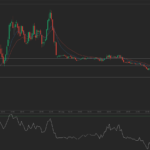 Natural gas fell on Tuesday on forecasts for mild weather across most of the US, following five straight days of gains fueled by a somewhat bullish inventory report last week and projections for a near-average stockpiles build this Thursday.
Natural gas fell on Tuesday on forecasts for mild weather across most of the US, following five straight days of gains fueled by a somewhat bullish inventory report last week and projections for a near-average stockpiles build this Thursday.
Natural gas for delivery in June traded 0.71% lower at $2.801 per million British thermal units at 8:04 GMT, shifting in a daily range between $2.812 and $2.796. The contract rose 1.6% on Monday, extending four days of gains, after settling last week 8.1% higher.
According to NatGasWeather.com, natural gas demand in the US will be very low compared to normal through May 11th, with bearish weather factors set to continue the week after.
Pleasant temperatures have spread across most of the country, with highs in the uppers 60s through lower 80s over the North and 70s and 80s down South. Many regions continue to experience typical Spring weather with showers and thunderstorms, including Texas, the Rockies and the Plains. The southern Great Lakes and Ohio Valley will see similar conditions this week as well. The West is off to a quite comfortable start to the week before a Pacific weather system arrives today and Wednesday, pushing temperatures several degrees below normal.
Next week, active weather in a typical Spring pattern will continue over much of the US, with the majority of the country expected to enjoy near-normal conditions, keeping both heating and cooling demand curbed. The eastern US has the best chances of being slightly warmer than normal, NatGasWeather.com said, while Texas and the Southwest are a few degrees cooler as weather systems with showers and thunderstorms pass through. However, higher-than-average readings are expected to return around mid-May.
Temperatures
According to AccuWeather.com, readings in New York will max out at 81 degrees Fahrenheit on May 6th, 13 above usual, and will remain in the upper 70s and low 80s through the third week of May, with a few exceptions. Chicago will peak at 70 degrees tomorrow, 3 above the average, and will be in the upper 60s and lower 70s through May 15th.
Down South, Houston will see temperatures peak at 85-86 degrees through May 12th, compared to the average 83-85, before easing a few degrees afterwards. On the West Coast, highs in Los Angeles will be at 64-69 degrees through may 10th, compared to the average of 74, before rising to the mid 70s over the following week.
Inventories
Natural gas rallied more than 5% last Thursday after the Energy Information Administration reported that US natural gas stockpiles rose by 81 billion cubic feet in the week ended April 24th, below analysts’ median estimate of +85 bcf. The five-year average gain for the period was +55 bcf, while supplies rose by 77 bcf during the comparable period a year earlier.
Total gas held in US storage hubs amounted to 1.710 trillion cubic feet, narrowing the deficit to the five-year average of 1.785 trillion to 4.2%, or 75 bcf, from 5.8% a week earlier. Inventories were at a surplus of 76.5% compared to year-ago stockpiles of 969 bcf.
This Thursday’s inventory report is expected to show a slightly larger-than-average gain, around +70-75 bcf, as cooler temperatures over the North last week induced slightly stronger heating demand. The five-year average build for the week ended May 1st is +68 billion cubic, while stockpiles gained 75 bcf during the comparable period a year earlier.
Next week’s report, due out on May 14th, will likely reflect a larger gap to the average, as temperatures even across the North warmed up this week. The five-year average inventory gain for the seven days ended May 8th is +82 bcf, while stockpiles rose by 101 bcf a year earlier.
Pivot points
According to Binary Tribune’s daily analysis, June natural gas futures’ central pivot point stands at $2.794. In case the contract penetrates the first resistance level at $2.851 per million British thermal units, it will encounter next resistance at $2.880. If breached, upside movement may attempt to advance to $2.937 per mBtu.
If the energy source drops below its S1 level at $2.765 per mBtu, it will next see support at $2.708. In case the second key support zone is breached, the power-station fuel’s downward movement may extend to $2.679 per mBtu.
In weekly terms, the central pivot point is at $2.686. The three key resistance levels are as follows: R1 – $2.890, R2 – $3.005, R3 – $3.209. The three key support levels are: S1 – $2.571, S2 – $2.367, S3 – $2.252.





